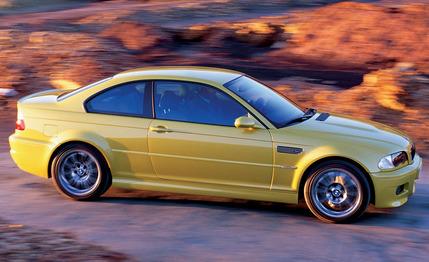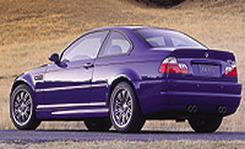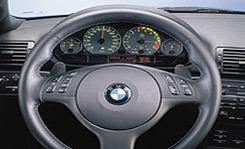
 Short Take Road Test
Short Take Road Test
The petrochemicals pumping through your veins predispose you to row a manual transmission, but the spouse sharing the car payment--or the clutch leg, charley-horsed in commuter traffic--argues otherwise. Your options? An inherently less-efficient automatic dressed up with manual shift buttons or a slightly jerky-shifting manual transmission with robotized shifting and clutch (assuming your needs and budget can handle a Toyota MR2, a Ferrari, or a Maserati). To these options, add BMW's second-generation sequential manual gearbox (SMG), a $2472 option on the $47,771 M3.


SMG first appeared in Europe in 1996 and has recently accounted for half of all M3 sales outside the U.S. The transmission itself is the same Getrag Type-D six-speed used in the three-pedal M3, replete with traditional synchronizers and shift forks. (True sequential boxes used in motorcycles and race cars often do without synchronizers, relying on dog clutches alone--think of a ring of pins sliding into a ring of holes--to engage gears, and the shift forks are moved by a rotary drum that makes it impossible to skip a gear when shifting up or down.) To it are bolted several electrohydraulic cylinders operating under the direction of a Siemens controller.
This electronic brain allows the driver to choose between five automatic (A) modes and six sequential (S) manual modes. Shoving the stubby gear lever to the right selects between S and A, and a rocker switch shuttles between the various Drivelogic programs. There's a hill-start assist that feathers the clutch to keep the car from rolling as you step from brake to throttle, and a slip-alert system that prevents wheelspin on deceleration even with dynamic stability control (DSC) switched off. Fear not, power-on wheelspin is allowed.
A1 mode is for low-traction situations. The car steps off in second gear (with more clutch slippage than in other modes) and executes smooth, fairly slow shifts (lasting about one second) at relatively low revs to limit torque. A2 feels similar, except that it launches in first gear. These are mother-in-law-onboard modes. Settings A3 through A5 quicken the shifts and raise the shift points. At 60 mph, A4 and A5 will allow a six-three downshift; A1, A2, and A3 only kick to fourth. Drivelogic is programmed to hold lower gears in hilly or sporty running, but it tended to run a gear too high in most curves on our handling loop in A5 mode, so S is the ticket in the twisties. SMG won't be mistaken for a torque-converter automatic, but the A-mode shifts are more convincing than those executed by any other automated manual we've tried.
Sequential modes S1 through S5 mirror the speeds and smoothness of the A-mode shifts. To upshift, either tug on the steering wheel's right paddle or pull the stubby shift lever backward. For a downshift, use the left paddle or push forward on the stick. The lever's logic seemed backward to us, so we used the paddles almost exclusively.


We didn't find much use for the lower S modes, figuring that languid shifts are best left to the automatic mode. To engage S6, you must first switch off the DSC. Shifts happen in the blink of an eye in this mode--the quickest take as little as 0.08 second. By comparison, the Ferrari 360 F1's 0.15-second shifts feel as leisurely as lunch at il Cavallino. The tires bark in second gear. They'll atomize in first. As the tach needle passes 7500 rpm, the amber lamps used to indicate max engine speed during warm-up on all M products illuminate sequentially in counterclockwise fashion until a red lamp at 4000 lights up to indicate it's time to upshift as the engine hits its 8000-rev redline.
In Europe an acceleration-assist feature is programmed in to automate a 4000-rpm clutch-drop, clutch-slip launch, but an internal counter permits only one such launch per hour, 30 for the life of the clutch. We won't get that, so for best results engage S6, floor the throttle to call for an aggressive clutch drop, then back off to 75 percent to allow the tires to hook up at about 3000 rpm. Then keep your foot down, upshifting at 8000 rpm.
This technique can't beat an expert's foot on a clutch, however. Our most recent three-pedal M3 outran the SMG by 0.3 second, with the entire advantage gained in first gear. The SMG hit 60 mph in 4.8 seconds and ran the quarter in 13.4, 0.3 second slower than our long-term M3 at both points, and each crossed the quarter-mile at 107 mph, suggesting they were equally powerful. Running in the A5 mode slowed the SMG by another 0.2 second.
BMW claims that performance, not convenience, is SMG's raison d'être. Our numbers don't prove that out, but we do think there's $2472 worth of convenience here.